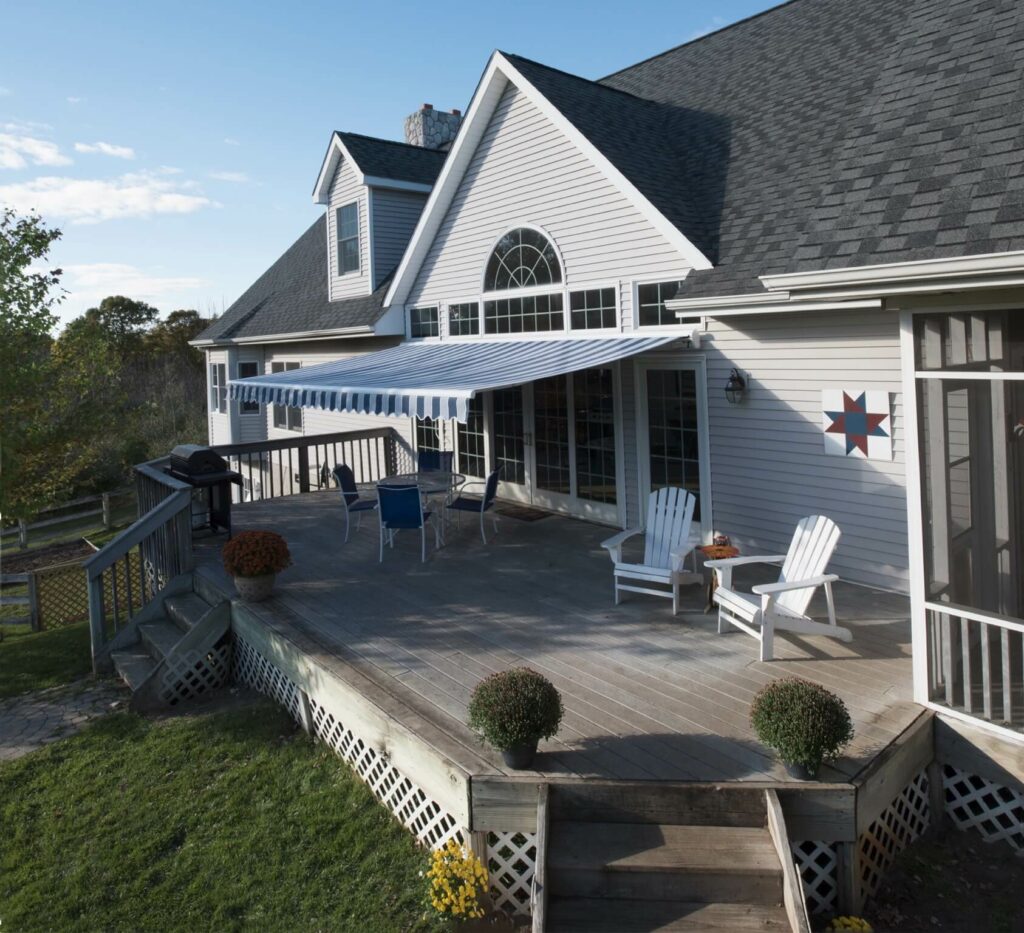An awning is a great asset to your home or business. They offer many advantages to you, your family, or your customers. Awnings are perhaps best known for protecting people from the elements. However, this doesn’t mean that you should let your awning itself go unprotected!
Although awnings are very sturdy, they can be damaged by wind if you don’t take preventative measures.
Here are a few steps you can take to ensure your awning is protected from wind damage.
How Do You Know If Wind Will Damage Your Awning?
If you aren’t sure if the windy conditions have the potential to damage your awning, keep the following in mind:
- A high wind can cause awnings to flap in the wind. You may also hear squeaking.
- Tears and holes in your awning material are another sign of damage caused by wind.
- If it’s too windy for you to feel comfortable sitting outside under your awning, it’s probably too windy for your awning!
Choose a Retractable Awning
Protecting your awning from wind damage should begin before you’ve even brought your awning home! If you live in an area prone to wind, a retractable awning is the best option. Retractable awning frames provide protection for your fabric by getting it out of the way when not in use so it’s safe and sound inside its frame.
Don't Use a Cheap, Flimsy Awning
You should choose an awning made from durable materials that are wind-resistant. Polyester and acrylic fabrics are best, since they’re less likely to break in the wind.
Although a low price may be attractive, cheaply made awnings can easily be blown away by wind. If you live in a windy area, you will want to invest in a high-quality retractable awning.
Use the Appropriate Awning Accessories
There are plenty of accessories available to help protect your awning from the wind. If you live in a windy area, these are great options:
Add Wind Poles
You should also consider using wind poles to make sure the awning is properly supported and secured. This way your awning will be securely anchored in place and stay upright, preventing any damage from wind!
Consider a Wind Sensor
If you’re worried about winds, Marygrove Awnings offers a wind sensor that can detect motion and will automatically roll your awning in for you, giving you extra peace of mind.
Create a Windbreak to Protect Your Awning from the Wind
A windbreak can also help protect your awning.
You can plant a hedge, set up a fence, or install an obstruction to protect your awning from the side of your home.
This will help provide natural protection against gusts that blow in from one direction and keep it more stable during strong winds. You may want to have two different types of obstructions at different angles and heights to protect your awning from different directions.
Remember to Maintain Your Awning
Keeping your awning in good condition will help prevent wind damage. As they say, prevention is the best cure!
Here’s how to care for your awning:
Wash Your Awning
Gently clean your awning off with a hose and use a mild detergent if there are stains or soiling. Avoid using bleach and other harsh chemicals, as these can permanently damage your awning!
You should also clean your awning off after a rain to prevent mildew and mold from forming.
Examine the Fabric
Check the condition of the fabric often to make sure there are no rips or tears in it. If you see any signs of wear and tear, contact a professional to repair it for you. You should inspect your awning on a regular basis- at least once every few weeks. If you find any damage, act quickly. Rips can become much worse (and more expensive to fix) as time goes on.
Tighten Loose Hardware and Stems
Tighten up all screws to keep everything sturdy and tight. Check that all of your stems are in good condition as well. Make sure that retractable parts such as pulleys are working well.
Replace Damaged Parts
If there’s a part of the awning that is damaged, be sure to replace it. This includes the fabric and any hardware that is necessary for retractable awnings.
Keep an Eye Out for Rust
You should also be on the lookout for any rust, corrosion or mold. If you see any, you’ll need to remove it or contact a professional so they can come take care of it for you.
Be Careful of Your Awning's Surroundings
Keep your awning leaf-free by making sure there is nothing near or on it that can damage the fabric. One of the most common causes of damage to an awning is the build up of foliage and other greenery resulting in tough, rubbing branches that tear at the material.
You should avoid barbecuing under your awning. Using the grill and barbecue under your awning may cause damage. Temperature differences can weaken or break the fabric, which may lead to poor wind resistance.

In Conclusion
Wind can be damaging to your awning and it’s important that you take the steps necessary to protect it. You’ll need an awning that is designed for inclement weather if windy conditions are common in your area. It will also help to anchor the awning properly, as well as care for it with regular maintenance so all of these precautions won’t go into waste! Do you have the right protective measures in place?


